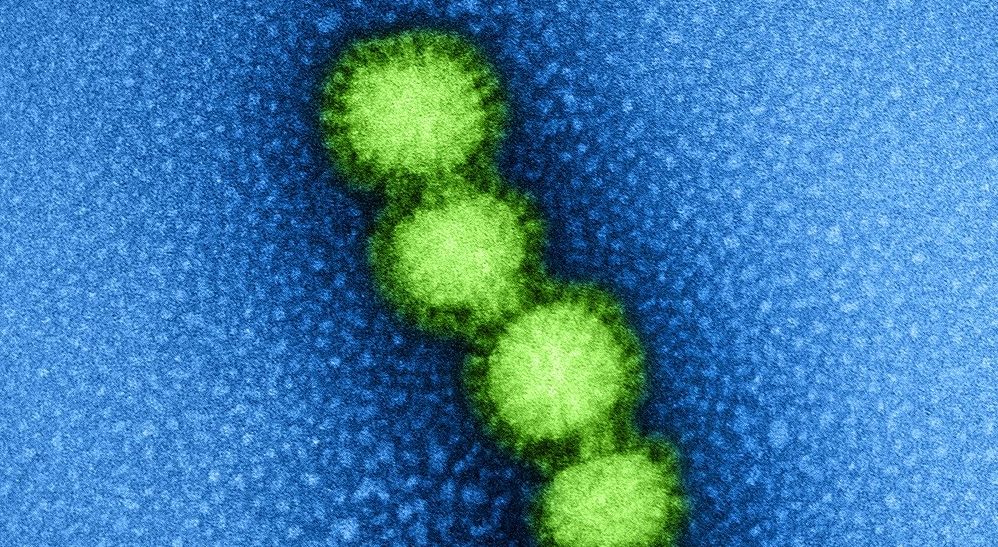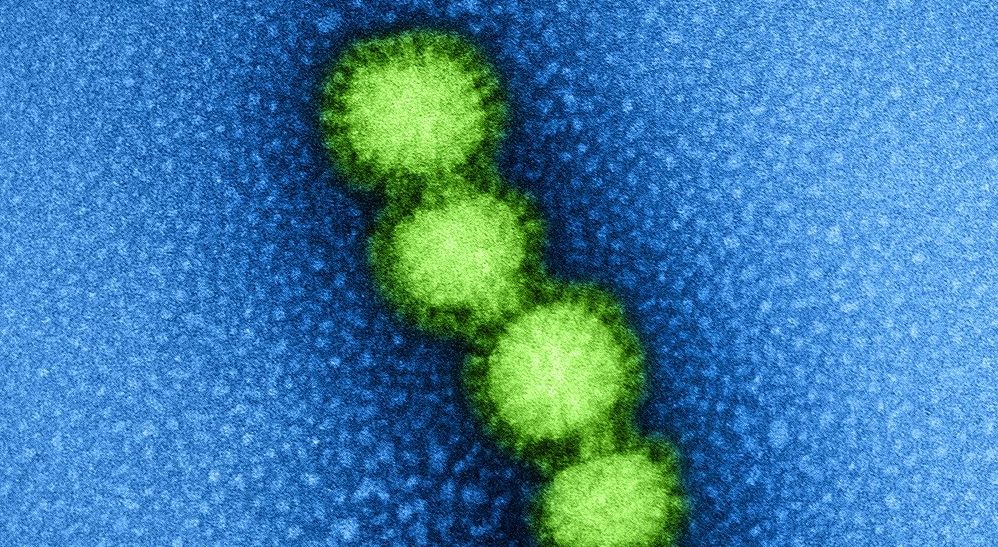Human Brain Directly Attacked by COVID-19, by ShepherdFarmerGeek


I ran across this report while doing some COVID-19 research online. If I’m understanding it correctly this is a major insight into how the virus attacks humans, especially in the more serious cases. And it’s implications may give us a useful strategy to attempt to combat it.
Here’s the original research article, published February 27, 2020.
If I may, let me try to put the article’s main findings (below in italics) into everyday English:
Here’s The Problem
The COVID-19 virus can infect a person through any mucous membranes – the mouth, eyes and nose. Infections via the mouth are typically from touching contaminated surfaces or objects (foamites) and the viruses are subsequently transferred to the mouth or eyes. Having virus-laden saliva particles drift into a person’s eyes is a second way infections happen and is why the best protective strategy includes non-vented goggles.
Of course the major route of infection is by breathing virus-laden particles into the lungs where they have a particular affinity (as well as the intestines). And people typically breathe through their noses most of the time. Doctors and researchers have now discovered that COVID-19 viruses can travel from the nose [and even the lower respiratory airways] to the brain stem where they infect the Central Nervous System (CNS).
There, the viruses attack the body’s normal ability to breathe spontaneously (without conscious effort). This is especially a problem when the person tries to sleep, but conscious effort is required to continue breathing. Hence the heavy use of mechanical respirators. Persons whose infection primarily started via breathing and nasal inhalation would be expected to experience respiratory crises more often / more seriously than persons infected via the fecal-oral or eye route.
Will nasal washing help?
Given this issue, washing the viruses out of the nose and throat might be one useful defensive strategy. We know that N-95 masks are not perfect (hence the 95% protection rating) and some viral exposure can still happen. But the exposure can be so little that the body’s normal defenses can inactivate the invading viruses. I would propose that we use a saline nasal wash (for heaven’s sake don’t spray ordinary water or distilled water into your noses! It burns, so use saline). And maybe use a saline that has some antiviral substance(s) added to help combat the viruses and wash them out of the nose?
Additives
A lot of people would propose colloidal silver and that could be one option. It’s certainly popular among preppers. Xylitol could help and nasal sprays containing Xylitol are specifically marketed to help flush the sinuses. According this National Institutes of Health article:
“GSE [grapefruit seed extract] is a potential novel disinfectant against viruses and bacteria, effective even within a short contact time.” We do not know if it will specifically work against COVID-19, but it’s also not likely to cause any harm if we only add a few drops to a saline nasal spray.
Finally, we know from an earlier SurvivalBlog article and comments that Betadine / Povidone Iodine kills viruses. At the time the author recommended swabbing the nose with this solution (which might be a bit tingly…), but it might work better if it was sprayed (diluted!) from a saline spray bottle (like Simply Saline, NeilMed nasal rinse, and OCEAN saline spray – all just a couple of bucks at your local pharmacy).
Selenium, Zinc, Olive Leaf Extract, Vitamins C and D, and other supplements and vitamins have antiviral properties – but we do not know if that property requires their ingestion/digestion first or if they’ll work directly on a virus via a nasal spray. And for all I know some of these substances could be p-r-e-t-t-y unpleasant when sprayed into a nose! I’m not personally recommending anything beyond GSE (which I’ve used in saline wash for years) and Betadine. Now that research like this article has been published I’d expect a flurry of research about what type of spray additives works best.
Our strategy
For me and my family, we’re planning to add a round of saline spray with GSE and Betadine after every public exposure even though we will be wearing high quality filter masks. And in more controlled settings where infected persons are unlikely to be present I would think it would still be prudent to occasionally give the old sinuses a rinse, maybe once an hour or two? And we’ll follow the nasal rinses with some drink to help wash the viruses off the mucus in our esophagus and into the acid bath of the stomach.
This won’t be a solution, and it definitely won’t be a cure, because these viruses can still travel from the lungs to the brain in theory, but this might be a way to minimize or reduce our exposure to the virus itself. And it might be a way to try to prevent the worst COVID-19 symptom – acute respiratory distress. Only time will tell and I’m throwing this out to the prepper community simply because time is of the essence.
And please, this should also be the end of the absurd public arguments that N-95 (and better) filter masks are not important for protection from COVID-19, even though doctors and nurses require them.
So, mask up, use those non-vented goggles, spray your noses and for heaven’s sake, practice good hand hygiene! Stay out of crowds as much as you can. Any one of these measures alone is not enough. You need a comprehensive strategy!
Here’s the Abstract
The article’s Abstract from [Originally sourced by this in the Comments section!]
SFG: Underlines, bolds and [comments in brackets] are my emphasis.
“Following the severe acute respiratory syndrome coronavirus (SARS‐CoV) and Middle East respiratory syndrome coronavirus (MERS‐CoV), another highly pathogenic coronavirus named SARS‐CoV‐2 (previously known as 2019‐nCoV) emerged in December 2019 in Wuhan, China, and rapidly spreads around the world. This virus shares highly homological sequence with SARS‐CoV, and causes acute, highly lethal pneumonia (COVID‐19) with clinical symptoms similar to those reported for SARS‐CoV and MERS‐CoV. The most characteristic symptom of COVID‐19 patients is respiratory distress, and most of the patients admitted to the intensive care could not breathe spontaneously. Additionally, some COVID‐19 patients also showed neurologic signs such as headache, nausea and vomiting. Increasing evidence shows that coronavriruses are not always confined to the respiratory tract and that they may also invade the central nervous system inducing neurological diseases. The infection of SARS‐CoV has been reported in the brains from both patients and experimental animals, where the brainstem was heavily infected. Furthermore, some coronaviruses [SFG: But not COVID-19, yet] have been demonstrated able to spread via a synapse‐connected route to the medullary cardiorespiratory center from the mechano‐and chemoreceptors in the lung and lower respiratory airways. In light of the high similarity between SARS‐CoV and SARS‐CoV2, it is quite likely that the potential invasion of SARS‐CoV2 is partially responsible for the acute respiratory failure of COVID‐19 patients. Awareness of this will have important guiding significance for the prevention and treatment of the SARS‐CoV‐2‐induced respiratory failure.”
Fuller Summary
And here is the fuller summary from the original research article:
“Following the severe acute respiratory syndrome coronavirus (SARS‐CoV) and Middle East respiratory syndrome coronavirus (MERS‐CoV), another highly pathogenic coronavirus named SARS‐CoV‐2 (previously known as 2019‐nCoV) emerged in December 2019 in Wuhan, China, and rapidly spreads around the world. This virus shares highly homological sequence with SARS‐CoV, and causes acute, highly lethal pneumonia (COVID‐19) with clinical symptoms similar to those reported for SARS‐CoV and MERS‐CoV. The most characteristic symptom of COVID‐19 patients is respiratory distress, and most of the patients admitted to the intensive care could not breathe spontaneously. Additionally, some COVID‐19 patients also showed neurologic signs such as headache, nausea and vomiting. Increasing evidence shows that coronavriruses are not always confined to the respiratory tract and that they may also invade the central nervous system inducing neurological diseases. The infection of SARS‐CoV has been reported in the brains from both patients and experimental animals, where the brainstem was heavily infected. Furthermore, some coronaviruses [SFG: But not COVID-19, yet] have been demonstrated able to spread via a synapse‐connected route to the medullary cardiorespiratory center from the mechano‐ and chemoreceptors in the lung and lower respiratory airways. In light of the high similarity between SARS‐CoV and SARS‐CoV2, it is quite likely that the potential invasion of SARS‐CoV2 is partially responsible for the acute respiratory failure of COVID‐19 patients. Awareness of this will have important guiding significance for the prevention and treatment of the SARS‐CoV‐2‐induced respiratory failure.”
Fuller Summary
And here is the fuller summary from the original research article:
“Taken together, the neuroinvasive propensity has been demonstrated as a common feature of CoVs. In light of the high similarity between SARS-CoV and SARS-CoV2, it is quite likely that SARS-CoV-2 also possesses a similar potential. Based on an epidemiological survey on COVID-19, the median time from the first symptom to dyspnea [SFG: difficulty breathing] was 5.0 days, to hospital admission was 7.0 days, and to the intensive care was 8.0 days 15. Therefore, the latency period is enough for the virus to enter and destroy the medullary neurons [SFG in the brain stem]. As a matter of fact, it has been reported that some patients infected with SARS-CoV-2 did show neurologic signs such as headache (about 8%), nausea and vomiting (1%).
The implications of the potential neuroinvasion of SARS-CoV-2.
As an emerging virus, no effective treatment has been developed for the disease resulting from SARS-CoV-2. Therefore, awareness of the possible entry of SARS-CoV-2 into the CNS will have important guiding significance for the prevention and treatment.
If the neuroinvasion of SARS-CoV-2 does take a part in the development of respiratory failure in COVID-19 patients, the precaution with masks will absolutely be the most effective measure to protect against the possible entry of the virus into the CNS. It may also be expected that the symptoms of the patients infected via facal-oral or conjunctival [SFG: eyes] route will be lighter than those infected intranasally. The possible neuroinvasion of SARS-CoV-2 may also partially explain why some patients developed respiratory failure, while others not. It is very possible that most of the persons in Wuhan, who were the first exposed to this previously unknown virus, did not have any protective measure [SFG: such as masks, so people were heavily infected via breathing and breathing through their noses], so that the critical patients is much more in Wuhan than in other cities in China.
Considering the potential neuroinvasion of SARS-CoV-2, antiviral therapy should be carried out as early as possible to block its entry into the CNS. Airway inhalation of antiviral agents will be the first choice at the early stage of infection, which will inhibit the replication SARS-CoV-2 in the respiratory tracts and lung and prevent from its subsequent neuroinvasion. It is also urgent to find effective antiviral drugs that can cross the blood-brain barrier. Moreover, corticosteroids, which are used frequently for severe patients, may have no treatment effect, but rather accelerate the replication of the virus within the neurons.
Since SARS-CoV2 may conceal itself in the neurons from the immune recognition, complete clearance of the virus may not be guaranteed even the patients have recovered from the acute infection. In support of this, there is evidence that SARS-CoV-2 is still detectable in some patients during the convalescent period 43. Therefore, given the probable neuroinvasion the risk of SARS-CoV-2 infection may be currently underestimated.”
Trust God. Be prepared. You can do both.
ShepherdFarmerGeek
